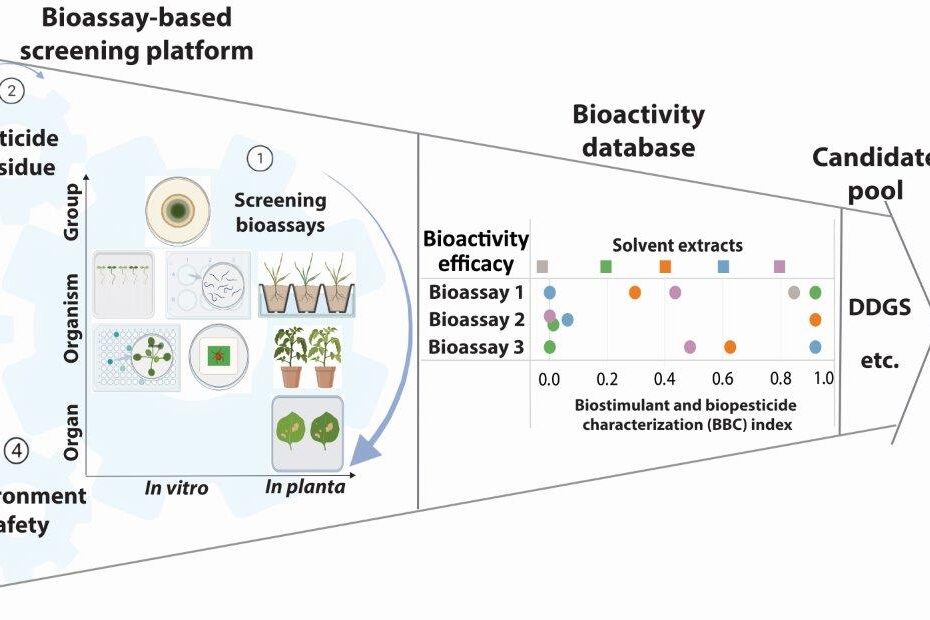News, paper
Abstract: A collection of by-products was surveyed for novel biostimulant and biopesticide activity by establishing a
screening platform (Bio2Bio) that integrated a broad spectrum of in vitro and in planta bioassays. Here, we report
plant growth-promoting and biopesticide activities obtained from four solvent extracts of maize distillers’ dried
grains with solubles (DDGS), a bioethanol fermentation by-product. The hexane extract stimulated Arabidopsis
primary root growth, whereas the ethanol extract enhanced tomato shoot growth and fresh biomass. The water
extract showed fungicide, acaricide, nematicide, and protective activities, specifically conferring disease tolerance by inducing the plant immune response. We demonstrate significant biopesticide effects of DDGS water
extract against the fungus Magnaporthe oryzae (32 % in vitro efficacy), oomycete Phytophthora infestans (73 % in
planta efficacy), and spider mite Tetranychus urticae (60 % in vitro efficacy), as well as plant-induced resistance
against the fungal pathogen Botrytis cinerea (30 % in planta efficacy) and root-knot nematode Meloidogyne graminicola (91 % in vitro and 50 % in planta efficacy). The broad range of bioactivities suggests that DDGS is a
complex mixture composed of a wide variety of plant metabolites. DDGS represents a valuable source for
discovering bioactive ingredients with potential use as biostimulants and/or biopesticides.
Keywords: Bioactive compounds, Bioassay, Biostimulant, Biopesticide, Maize distillers’ dried grains with solubles, (DDGS), Screening platform
Jing Li a, Hoang Khai Trinh a,b, Seyed Mahyar Mirmajlessi c, Geert Haesaert c, Ramize Xhaferi d, Ilse Delaere d, Monica Hofte d, Katrijn Raymaekers e, Bruno P.A. Cammue e, Wim Jonckheere f, Thomas Van Leeuwen f, Lien De Smet g, Tina Kyndt g, Nathalie Bernaert h, Christof Van Poucke h, Bart Van Droogenbroeck h, Emmy Pequeuri, Karel De Schamphelaere i,, Gert Callebautj, Timoty De Cleyn j, Lin Xu a, Aldana Ramirez a, Thijs Van Gerrewey a, Danny Geelen a,*
a HortiCell, Department Plants and Crops, Faculty of Bioscience Engineering, Ghent University, Coupure Links 653, 9000 Ghent, Belgium
b Institute of Food and Biotechnology, Can Tho University, 900000 Can Tho City, Vietnam
c Department of Plants and Crops, Faculty of Bioscience Engineering, Ghent University, Diepestraat 1, 9820 Bottelare, Belgium
d Laboratory of Phytopathology, Department Plants and Crops, Faculty of Bioscience Engineering, Ghent University, Coupure Links 653, 9000 Ghent, Belgium
e Centre of Microbial and Plant Genetics, KU Leuven Plant Institute, Kasteelpark Arenberg 20, 3001 Leuven, Belgium f Laboratory of Agrozoology, Department Plants and Crops, Faculty of Bioscience Engineering, Ghent University, Coupure Links 653, 9000 Ghent, Belgium
g Department of Biotechnology, Faculty of Bioscience Engineering, Ghent University, Coupure Links 653, 9000 Ghent, Belgium
h Flanders Research Institute for Agriculture, Fisheries and Food (ILVO), Technology and Food Science Unit, Brusselsesteenweg 370, 9090 Melle, Belgium
i Laboratory of Environmental Toxicology and Aquatic Ecology, Department of Animal Sciences and Aquatic Ecology, Faculty of Bioscience Engineering, Ghent University,
Ghent University, 9000 Ghent, Belgium
j S.A. Ajinomoto OmniChem NV, 9230 Wetteren, Belgium
